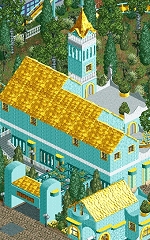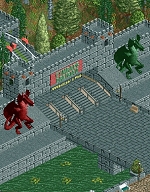|
From the plaza, the path takes visitors down to the central Piazza. Here, perhaps, is the first indication of the sheer experimentation present in Ellis's style. From this one location, guests can clap eyes on Gothic, Art Deco, Queen Anne and Villa style architecture, all surrounding this one Piazza. Indeed, one could be fooled into thinking Ellis just couldn't make his mind up about what style to follow, but the truth is probably more wholesome - Ellis truly loved his art, and saw Portmeirion as his chance to pay homage to all he held dear.
Some of the most exuberant buildings have now been adapted to house stations for the Village's rides - most notably the yellow/blue Baroque style building to the left of the square, now home to 'Neptune', a B&M multi-element twister. It is not the aim of this article to appraise the quality of the amusements in this park, but Portmeirion has been widely praised for building quality rides in a restrained and respectful way, keeping almost all the original architecture intact and keeping obstruction to the minimum. Also, coaster fans may like to know The Rollercoaster Club of Great Britain wrote in their feature on the Village that Neptune was 'a very enjoyable ride, with enough airtime to rival Chris Moyles'.
Direct across the Piazza from Neptune is an altogether different piece of architectural radicalism - the gothic entrance to the Welsh Dragon dueling inverted coaster, again from B&M. Ellis's fascination with the great castles of eastern Europe led him to create a ruinous castle, complete with stone access bridge and
spiraling turrets. The building's outposts stretch far into the forest, so any wanderers could be forgiven for thinking that some mythical beasts COULD possibly be near! They wouldn't be too wrong, either, as large Dragon sculptures leer across the moat at any passers-by.
|


|